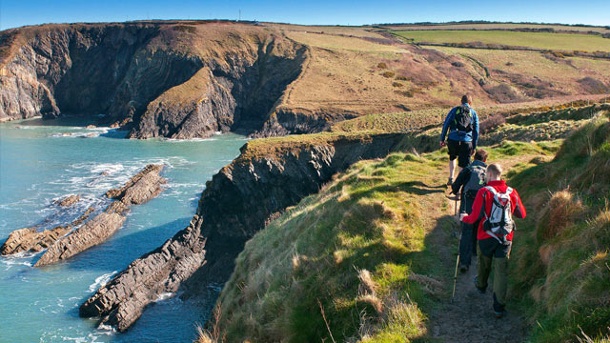Move on the longest coastal path in Europe
Wales is the smallest country of the United Kingdom. Even the longest coastal path in Europe – the Wales Coast Path – meanders here along the Irish Sea, rich meadows and bleating sheep. A few impressions we show you in our photo show.
870 miles or 1,400 kilometers, the trail long, runs along almost entirely on the coast of the smallest country in the British Empire. Blue signs with a yellow shaft indicate the way. He starts in Queensferry, orbits about 200 kilometers, the island of Anglesey and leads in the south to Chepstow. “Would you want to hike the entire Coast Path, one would be safe on the road eight weeks,” says Harri Roberts. He has written several guide books on the way.
Many sections of the Cost Paths lead over beaches and coves of the approximately 1,200-kilometer coast of Wales. But time and again it comes to hills and mountains, on cliffs and meadows where sheep bleat and cows hinkauen right. The weather is not to be underestimated. “The wind is blowing in your face, no matter what direction you go on the road,” says Roberts. And then Wales is still one to one of the wettest countries in Europe.
Along the way, attract many sights and places
In 2012, the Coast Walk has been taken after five years of preparation into operation. Time needs of travelers for the many sights: castles, palaces, churches and monasteries are often only a few steps away. And places that look like foreign objects in the landscape. Portmeirion, for example, a kind of amusement park. They make you feel like in an Italian fishing village: colorful houses, beautiful flowers, to palm trees, statues and fountains. “Here, Sir Bertram Clough Williams-Ellis has realized a dream,” says the manager of the plant, Meurig Jones. “He wanted to bring beauty into the world, as it did not give them too much.”
That was after the First World War. 1925 bought the Welsh architect a small property at the edge of Snowdonia. And then he went on a search that would last all his life. “Basically, he was a compulsive hoarding,” says Jones. Clough Williams-Ellis but garnered no teacups or automobiles, but equal parts of mansions and other structures that have been presented to him or bequeathed for little money. “And so was born almost 50 years of the Gesamtkunstwerk, the Portmeirion is today.”
The architect made use of optical tricks and illusions, built together, which do not really fit together and in the end gave a great ensemble. His idea was to make from the beginning, the village on the hill into a tourist destination. When he died in 1978 at an advanced age, he had just one last wish: His ashes should be scattered with a fireworks display over Portmeirion.








Leave a Reply